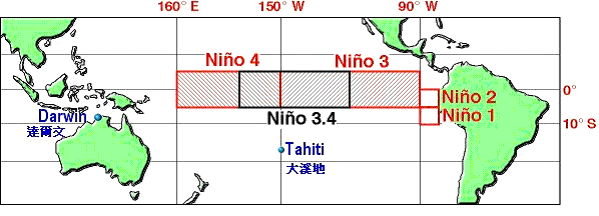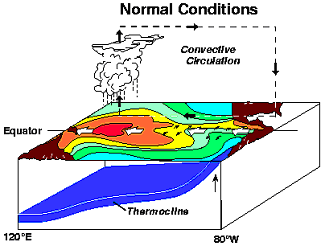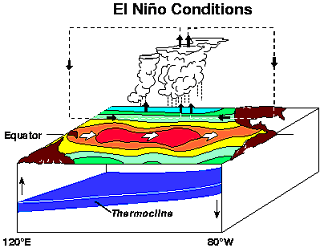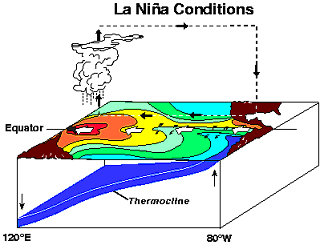Background Information
El Niño and La Niña refer respectively to the warming and cooling of surface waters over the central and eastern equatorial Pacific Ocean which affect the atmospheric circulation worldwide. (Click this link to jump to the definition of El Niño and La Niña event)
El Niño usually peaks around Christmas, hence the name of the phenomenon (Spanish for "the little boy" or "the Christ Child"). It recurs every few years, lasting 12 months or so. La Niña, "the little girl" in Spanish, occurs less frequently but lasts longer compared with El Niño.
Under normal atmospheric and oceanic conditions (i.e. without El Niño and La Niña, also known as the ENSO-neutral state), trade winds over the equatorial Pacific pile up warm surface water to the east of Indonesia. Warm water drives air to rise. Part of the air mass moves east aloft and descends near South America to form a feedback loop which is called the Walker Circulation (Figure 1).
(Source: National Oceanic and Atmospheric Administration, USA)
Figure 1 Normal atmospheric and oceanic conditions
During El Niño, trade winds over the equatorial Pacific are weaker than normal. Warm surface water over the western equatorial Pacific retreats east, causing sea surface temperature over the central and eastern equatorial Pacific to become higher than normal. Convection over the equatorial Pacific shifts east and hence affects the Walker Circulation (Figure 2).
(Source: National Oceanic and Atmospheric Administration, USA)
Figure 2 Atmospheric and oceanic conditions during El Niño
During La Niña, trade winds over the equatorial Pacific are stronger than normal. Warm surface water of the ocean is pushed further west. Convection over the ocean and the Walker Circulation shift accordingly (Figure 3).
(Source: National Oceanic and Atmospheric Administration, USA)
Figure 3 Atmospheric and oceanic conditions during La Niña
Another phenomenon, the Southern Oscillation, is closely related to El Niño and La Niña. The Southern Oscillation is an east-west balancing movement of air masses between the Pacific and the Indo-Australian areas. It is roughly synchronised and associated with typical wind patterns of El Niño and La Niña. The oscillation is measured by the Southern Oscillation Index (SOI), the difference between sea level atmospheric pressures at Tahiti and Darwin.
El Niño and La Niña are the oceanic components while the Southern Oscillation is the atmospheric counterpart. This combination gives rise to the term El Niño-Southern Oscillation (ENSO). In general, negative values of the SOI are associated with El Niño while positive values with La Niña. ENSO conditions are commonly defined with reference to the sea surface temperatures in the Niño regions (Figure 4).
 Figure 4 Graphical depiction of the four Niño regions and the location of Tahiti and Darwin for SOI Figure 4 Graphical depiction of the four Niño regions and the location of Tahiti and Darwin for SOI
Definition of El Niño and La Niña Event
The Observatory defines El Niño (La Niña) event based on the sea surface temperature (SST) anomaly index of the composite Niño region, i.e. Niño 1 to 4 region (see Figure 4). An El Niño (A La Niña) event is established when
(i) the SST anomaly index maintains at +0.5℃ or above (-0.5℃ or below) for at least 5 to 6 months; or
(ii) the SST anomaly index remains at +0.5℃ or above (-0.5℃ or below) for 5 consecutive months and the sum of anomaly reaches +4.0℃ or above (-4.0℃ or below).
|



